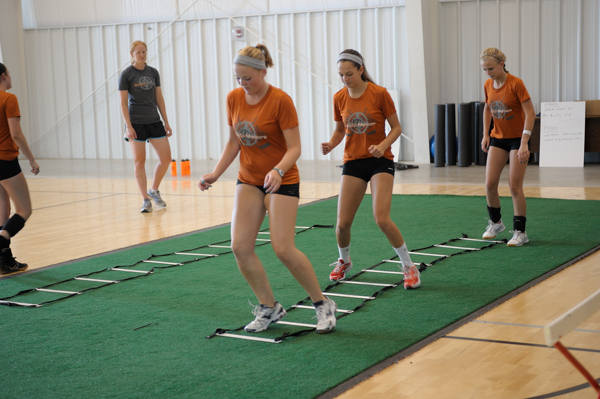Congratulations to the Team Priority Health MiTi finishers! Sunday was Michigan’s first ever Iron Distance Triathlon…. 
For those who don’t know, each competitor who did the Full Iron did this:
Swim: 2.4 miles
Bike: 112 miles
Run: 26.2 ( a full marathon)

People who did the half iron, did exactly half those distances. People doing the relay, had 3 team members each taking one discipline. The day started early, before sunrise with the Full Iron Athlete meeting at 6:45am and the race starting at 7. Iron distance athletes would have 17 hours to finish their race. I for one didn’t think to bring a headlamp for getting my bike ready in transition in the dark.

Transition for the race in the photo above was at Versluis Park in Plainfield Township. The lake was one of the most wonderful swims I have completed. Gas powered boats are not allowed and they say the water is considered safe to drink. It was like swimming in an aquarium, so clear and clean.

Teammate, Cricket Howard won the overall for the half aqua-bike. The Aqua-bike is the swim and bike legs, but no running. Cricket was the first person to cross the finish line of the day and he say’s the first time he has ever had the chance to run through finish line tape. I laugh when I see this photo because it looks like he doesn’t know what to do with the tape!

Here is a photo of me on my bike. This is by far my strongest discipline and favorite part of the race. Because I swim so slow, I need stellar transition and bike times to make up for it. The temps were hotter than forecast and really took a lot out of everyone. Lots of people did not finish and the run times were slow for most of the women as a result. During the bike leg, the temps hit 89, and then later in the afternoon, came clouds and thick humidity making it hard to breathe. The course was extremely hilly and we had a pretty good south wind that made some long open sections of the course very difficult. I managed the 2nd fastest bike time overall for the women, and it helped to bank some time for the run, something else I am not great at.

The run was for me, by far the hardest part of the race. The heat and humidity coupled with tired legs of the bike made it really hard keep going. When I hit the course, many of the half iron athletes were still out there and they were walking! I thought to myself, “how am I going to run 26.2 miles? ” The truth is, I didn’t run the whole thing but I was not alone. I ran as much as could, walking every aid station and parts of the hills. There was NOTHING flat on this course. Rollers the whole way. This was a really, really hard day for everyone! The picture below is of fast teammate, Katie Whidden, finishing off her half iron race.

I finished 20 minutes shy of my goal but given my placement, I was happy with the day. I finished 1st in my age group and 5th overall for the women.
Here are the results for my teammates:
Katie Whidden: 1st in age group, 7th overall (Half Iron)
Kelly Stimpson: 2nd in age group (Full Iron)
Cricket: 1st Overall (half – aqua-bike)
Dave “The Stud” Stebbins: 1st in his age group, 5th overall (Dave is in the 55-59 age group!!!! )
I would like to say THANK YOU to all of the fantastic volunteers without whom this would not have been such a successful event. Their contributions are absolutely a necessity and are priceless. As a participant I cannot express enough appreciation for what they do for us during the race. I would also like to thank all my teammates who came out and supported the runners and each taking a turn to run 0r bike part of my marathon with me: Roxane Kruse, Dan, Gauthier, Cricket Howard, Katie Whidden and Mark Olson.


The girls in the purple and blue ran me down in the marathon. They are both in their mid twenties. Maybe if I train harder, I can hang with them next time! Great job girls!







 Our Hockey Site
Our Hockey Site Team AM
Team AM


 e, restful sleep
e, restful sleep
 the project will include construction of new locker rooms and showers. In the meantime, our clients will enjoy that they no longer need gloves to touch the dumbbells in the winter months (current and past customers know what I mean). Parents will find a very comfortable and warm lobby with internet access, should they choose to wait while their athletes train.
the project will include construction of new locker rooms and showers. In the meantime, our clients will enjoy that they no longer need gloves to touch the dumbbells in the winter months (current and past customers know what I mean). Parents will find a very comfortable and warm lobby with internet access, should they choose to wait while their athletes train.

 reason your mother always told you to eat your fruits and vegetables. Fruits and veggies pack a nutritious punch and yet they do not contain a lot of calories. They are what we call “nutrient dense” foods and they are fantastic for you. Fruits and veggies contain heavy amounts of vitamins, minerals, fiber, enzymes and co-enzymes. Enzymes is the word used to describe something that helps speed up a process in the body; in other words, fruits and veggies help our body do the things it needs to do with less energy. This is one reason we feel more awake from an apple than from a cookie. Fruit does yield more of a glycemic response in the body, so aim to get more veggies than fruits everyday striving to make one of these vegetables servings some type of leafy green.
reason your mother always told you to eat your fruits and vegetables. Fruits and veggies pack a nutritious punch and yet they do not contain a lot of calories. They are what we call “nutrient dense” foods and they are fantastic for you. Fruits and veggies contain heavy amounts of vitamins, minerals, fiber, enzymes and co-enzymes. Enzymes is the word used to describe something that helps speed up a process in the body; in other words, fruits and veggies help our body do the things it needs to do with less energy. This is one reason we feel more awake from an apple than from a cookie. Fruit does yield more of a glycemic response in the body, so aim to get more veggies than fruits everyday striving to make one of these vegetables servings some type of leafy green.

 Now even better, with 4 class sessions, our popular and effective Stroke Analysis clinic is back this fall. Optimize your stroke and reduce your swim times.
Now even better, with 4 class sessions, our popular and effective Stroke Analysis clinic is back this fall. Optimize your stroke and reduce your swim times. 








